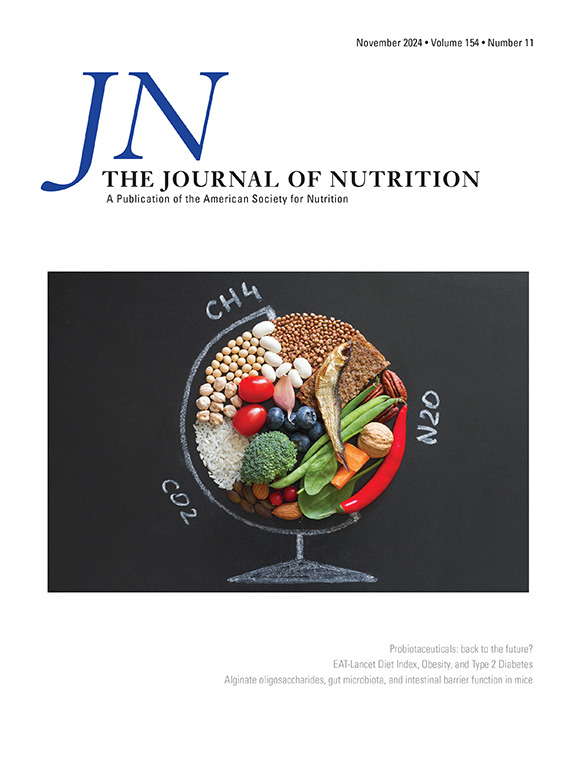双同位素示踪法与口回肠平衡法测定空心猪氨基酸消化率的比较。
IF 3.8
3区 医学
Q2 NUTRITION & DIETETICS
引用次数: 0
摘要
背景:双同位素示踪方法是一种侵入性较小的测量回肠氨基酸(AA)消化率的方法。目的:本研究旨在用标准化的口回肠平衡法验证双同位素示踪剂方法在生长猪中的应用。方法:8头猪采用颈静脉导管和回肠t型套管。在试验当天,每半小时提供含有本质标记的15n -乳蛋白和13c -螺旋藻的饲料,持续240 min。在0 ~ 540 min期间采集回肠食糜和10份颈静脉血样本,分析食糜样本的同位素富集、AA和钛浓度,以进行平衡法计算。测定血清AA同位素富集,进行双稳定同位素示踪计算。结果:采用口回肠平衡法,乳蛋白精料回肠AA消化率均值为97.8±0.59%,螺旋藻回肠AA消化率均值为81.5±2.44%(平均值±标准差)。赖氨酸消化率被特别评估,因为它不转氨化。双同位素示踪法计算的乳蛋白浓缩物赖氨酸消化率为88.9±8.35%,比口回肠法(98.1±0.36,P = 0.04)低9个点。Bland-Altman分析表明,两种方法之间的差异较大,赖氨酸消化率平均值较低。结论:在目前6头猪的实验条件下,本研究发现双同位素示踪法与口回肠平衡法在估算赖氨酸消化率方面存在差异。这一结果可能是由于方法问题。考虑到15N蛋白的使用,其他不转氨化的AA无法得出结论。本文章由计算机程序翻译,如有差异,请以英文原文为准。
Comparison of the Dual Isotope Tracer Approach with Oro-Ileal Balance Method for Determination of Amino Acid Digestibility in Cannulated Pigs
Background
The dual isotope tracer approach was developed as a less invasive alternative for the measurement of ileal amino acid (AA) digestibility.
Objectives
This study aimed to validate the dual isotope tracer approach with the standardized oro-ileal balance method in growing pigs.
Methods
Eight pigs were fitted with jugular catheters and ileal T-cannulas. On the test day, feed containing intrinsically labeled 15N-milk protein and 13C-spirulina was provided every half hour for 240 min. Ileal digesta and 10 jugular blood samples were collected between 0 min and 540 min. Digesta samples were analyzed for isotopic enrichment, AA, and titanium concentrations for balance method calculations. Serum AA isotopic enrichment was measured for dual stable isotope tracer calculations.
Results
Using the oro-ileal balance method, the mean ileal AA digestibility of milk protein concentrate was 97.8 ± 0.59% and of spirulina 81.5 ± 2.44% (mean ± standard deviation). Lysine digestibility was specifically evaluated, as it does not transaminate. Lysine digestibility of milk protein concentrate calculated according to the dual isotope tracer approach was 88.9 ± 8.35%, 9% point lower than the value obtained with the oro-ileal method (98.1 ± 0.36, P = 0.04). Moreover, Bland-Altman analysis showed that the difference between methods was higher, with lower mean lysine digestibility.
Conclusions
This study observed differences between the dual isotope tracer approach and the oro-ileal balance method for estimating lysine digestibility under the current experimental conditions with 6 pigs. This result may be due to methodological issues. Considering the use of 15N protein, conclusions on other AA that do not transaminate could not be drawn.
求助全文
通过发布文献求助,成功后即可免费获取论文全文。
去求助
来源期刊

Journal of Nutrition
医学-营养学
CiteScore
7.60
自引率
4.80%
发文量
260
审稿时长
39 days
期刊介绍:
The Journal of Nutrition (JN/J Nutr) publishes peer-reviewed original research papers covering all aspects of experimental nutrition in humans and other animal species; special articles such as reviews and biographies of prominent nutrition scientists; and issues, opinions, and commentaries on controversial issues in nutrition. Supplements are frequently published to provide extended discussion of topics of special interest.
 求助内容:
求助内容: 应助结果提醒方式:
应助结果提醒方式:


